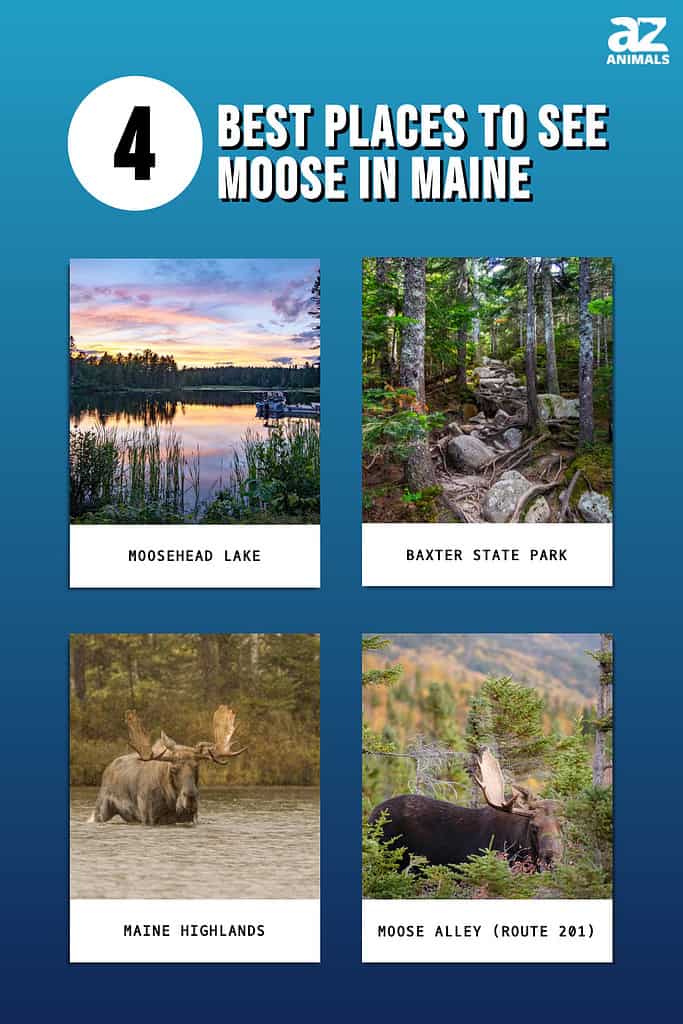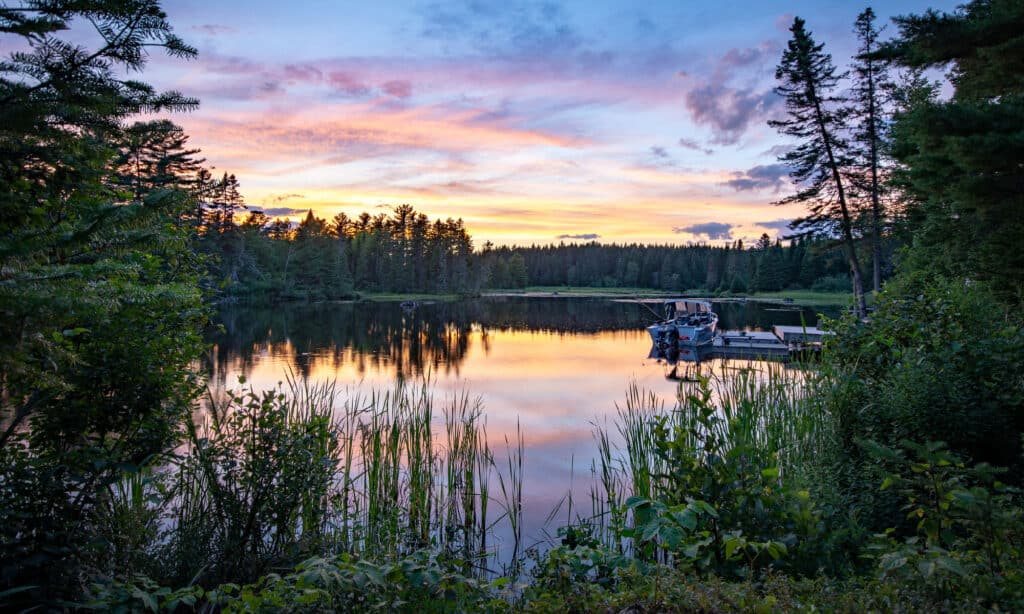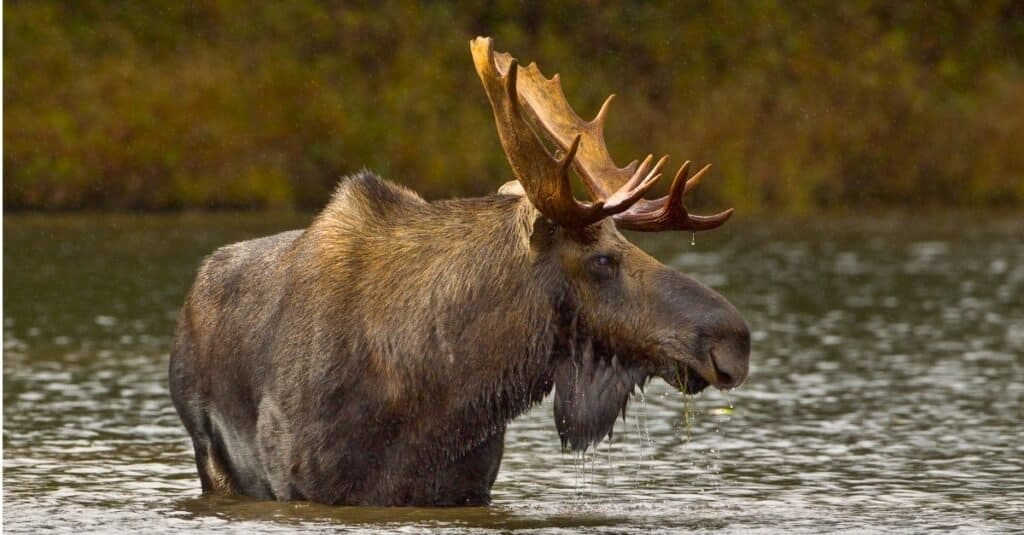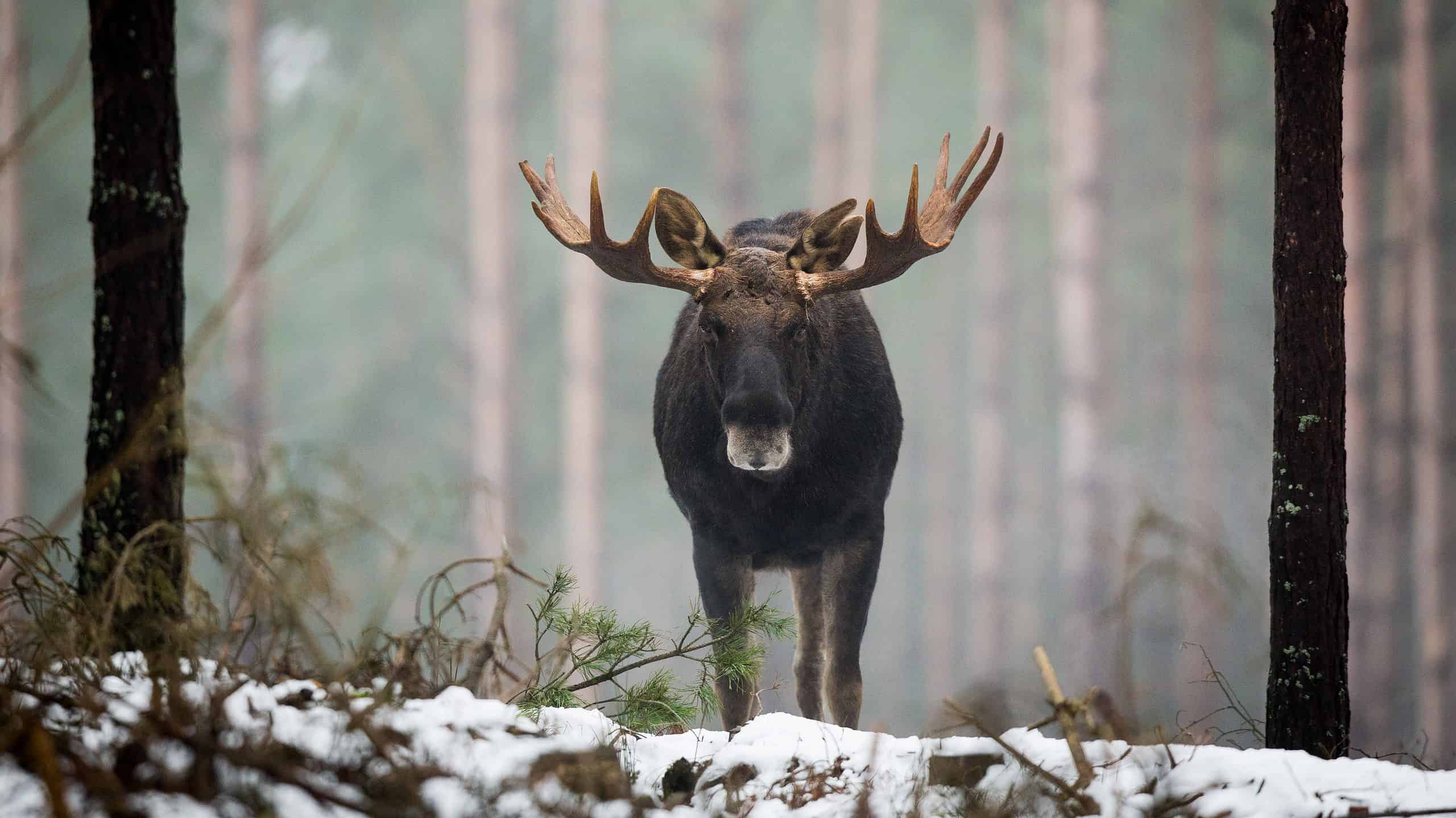When you think of Maine, it’s hard not to think of moose! These huge members of the deer family are extremely prevalent across the state, and in the continental United States, Maine is undoubtedly the “moose leader”. Seeing a moose, especially when you’ve never seen one, is always a unique event and a reminder of just how big these creatures are. Today, we are going to explore some of the best places to see moose in Maine, plus some of the ideal times for moose spotting. Let’s get started!

1. Moosehead Lake

With a name like “Moosehead Lake”, it’s no wonder this is a great spot to see some moose!
©iStock.com/mountinez
Moosehead Lake is the largest lake in Maine and the second-largest lake in New England. Over that large area, it covers about 120 square miles and has more than 80 islands (making it pretty much perfect moose territory). It is located in northwest Maine, about 150 miles north of Portland. You can get to Moosehead Lake by driving on Route 15 from Bangor, which takes about two hours. The largest nearby town is Greenville and it’s become a hub of sorts for the area.
Moosehead Lake is our first on the list as a prime moose-spotting spot, and it has a ton of opportunities to see them out and about in the wild. There’s a reason it’s called Moosehead Lake in the first place! You can take a boat ride on the lake and look for moose along the shorelines, especially in the early morning or evening. Additionally, doing some outdoor activities through the forests near the lake is a great way to increase your odds, especially if it’s quiet (walking or biking are good options). Some of the best places to see moose near Moosehead Lake are Lily Bay State Park, Rockwood, and Kokadjo.
2. Baxter State Park

A rocky area in the lush Baxter State Park.
©Jonathan A. Mauer/Shutterstock.com
Baxter State Park is a large wilderness area in northern Maine that covers more than 200,000 acres. It is home to quite a lot, but probably most famous as the home of Mount Katahdin, the highest peak in Maine, and the northern terminus of the Appalachian Trail. To get to Baxter State Park, you can drive from Bangor, Maine, which is about 100 miles away, or take a bus or shuttle service from nearby towns like Millinocket or Medway. You can also fly to Bangor International Airport and rent a car from there.
Baxter State Park is maybe one of the most famous places to spot moose in the state! In the park, some of the most common places to spot them are near ponds, lakes, streams, and wetlands, mostly because these are the places where they find food. Some of the best places to see moose in Baxter State Park are Sandy Stream Pond, Daicey Pond, Kidney Pond, and Togue Pond. If you want a near guarantee to see a moose here, there are even guided moose and outdoor safaris!
3. Maine Highlands

Moose sightings in northern Maine are quite common, and natives can see them while driving without having to even leave their car!
©iStock.com/RichardSeeley
The Maine Highlands is a region in central and northern Maine that encompasses some of the most scenic and rugged landscapes in the state. It is home to the largest lake, the longest river, and the tallest mountain in Maine, as well as more than 200 waterfalls and countless miles of hiking trails. To get to the Maine Highlands, you can drive from Portland, Maine, which is about 150 miles away. Technically, this large area encompasses the first two options on our list, but to be more broad about it, moose are extremely prevalent in this region, and seeing one is pretty likely if you look hard and long enough.
Again, here you can take a moose tour with a registered Maine guide, who will take you to the best spots to see them. Some of the best places in the highlands to see moose in the Maine Highlands (besides Baxter and Moosehead) are the Katahdin Woods & Waters National Monument and Penobscot River Corridor.
4. Moose Alley (Route 201)

Route 201 is a scenic byway that runs from Fairfield to the Canadian border in Maine–the perfect place to spot moose.
©ArtBBNV/Shutterstock.com
Moose Alley (Route 201) is a road that runs from Fairfield to the Canadian border in Maine. It is also known as the Old Canada Road Scenic Byway, and since forests, wetlands, and marshes border it, it has some prime moose-spotting locations. You can see moose at any time of the year, but the best times are in the spring and fall.
Along the route, The Forks, Jackman, and Moose River are all good places to drive through if you want to see some moose, probably without having to leave your car. These areas are all located near bodies of water and are pretty remote, making them good spots for moose to be seen.
The Best Times To See Moose in Maine
Seeing a moose isn’t too hard to do in Maine, but there are a few things that can definitely increase your chances. Let’s look at the best times (of the year and of the day), plus the best locations
Time of the year

The best times to see moose are during the fall, especially during the rut.
©crbellette/Shutterstock.com
The best seasons to see moose in Maine are spring and fall, but particularly in fall during the “rut.” The rut is their mating season, and they are less worried about humans (although that’s when they should be the most wary of them). In spring, moose come out of the woods to feed on the fresh vegetation and salt left by the melting snow. Winter and summer are not ideal seasons to see moose, as they tend to stay in the deep woods to avoid the cold and the heat, but it’s still possible to see them during these periods. When it snows, it can sometimes make them more visible since they stand out against the white, for example.
Time of the day
After nailing down a season to see them, it’s important to know when in the day to see them. Moose are crepuscular animals, which means they are most active during twilight hours (dusk and dawn). They will often feed along shorelines and travel during these times across open areas, which can make it easier to spot them. During the day, moose usually rest in shady areas and avoid direct sunlight. Still, as always, it’s not impossible to see them during the daylight hours, just less likely.
Location
The best places to see moose in Maine are areas that have a combination of forest, water, and open space. Moose prefer habitats that provide them with food, shelter, and water, and many of these habitats can butt up against one another in Maine. Swamps, forests, and open plains are often adjacent, and moose will travel between them depending on their needs.
The Moose Population In Maine
Maine is lucky enough to have one of the largest moose populations in the United States, second only to Alaska. According to state biologists, the Maine moose population is estimated to be around 75,000, which is about 60% of the total moose population in the lower 48 states. Moose are distributed throughout the state, but their density varies by region and habitat. The highest moose density is found in northern Maine, especially in Aroostook County. In fact, in Aroostook, there are three times more moose than humans! The lowest moose density is found in southern Maine, where moose are rare and mostly confined to protected areas, although this is still more than in most other states in the country.
Moose are also an iconic image in Maine, and they have become somewhat synonymous with much of New England!
- Alaska: 175,000 – 200,000
- Maine: 60,000 – 70,000
- Idaho: 10,000 – 12,000
- Washington: 5,000
- Minnesota: 4,700
- Wyoming: 3,500
- New Hampshire: 3,300
- Colorado: 3,000
- Vermont: 3,000
- Utah: 2,500 – 3,000
Thank you for reading! Have some feedback for us? Contact the AZ Animals editorial team.








